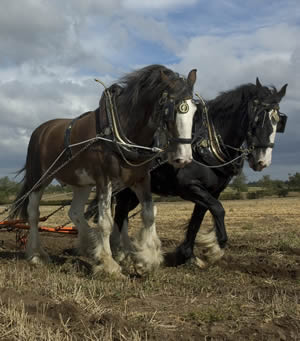History
The Shire horse, developed in England, traces it's history to the days of the Roman Conquest and is one of the oldest of the well-defined draft breeds. The name "Shire" also comes from England, and derives its name from the Saxon word "schyran," which means to shear or divide, hence the name "Shire," that is synonymous with county. King Henry VIII first applied the name "Shire" to the horse early in the 16th century.
Shires, in general, were used in the 16th century with paintings dating back to the 15th century that show them in the perfection of form. Without question, the Shire horse was used as a war-horse. Most people believe, and the story is told, that it was the Shire that was used by the knights, as they rode into battle, dressed in heavy armor with sword and lance poised. Everyone does not share this belief; however, even in England some doubt this as being true. However, with the passing of the tournament and heavily armored knight, the ancestor of the Shire Horse was put to work in harness pulling carts over rough roads and plows on the farm. The Shire became the largest and most powerful draft horse in Britain. It was, and still is, used by brewers in cities in stylish teams to pull beer wagons, in weight-pulling competition and in plowing competition.
The Shire was found and developed in all parts of England, but the counties of Lincoln, Derby, Cambridge, Norfolk, Nottingham, Leicester and Huntington, were the special homes. These are presently termed as the Midlands. History mentions the horse by different names notably, the Great Horse, the War-Horse, the Cart Horse, the Old England Black Horse, the Lincolnshire Giant as well as the Shire.
Like the other standard draft breeds, the Shire was improved by the infusion of outside blood at various times in history, notably that of the north German Flemish horses (Belgian) and the horses of Flanders. Reasonably good records exist, dating back nearly 1000 years. During this time outside blood continued to influence the breed as breeders were not hampered by a breed registry and no limits were imposed.
It was during the 18th century that this horse came into special use for draft and farm purposes. With the improvement of roads and the use of coaches, the draft horse came into special demand. During this time, Robert Bakewell greatly improved the Shire under the name of the Leicestershire Cart Horse, by introducing blood from Holland best, the Dutch Friesian.
Although the first Shire was imported to America in 1853, substantial importation did not begin until after the 1880's. As the new century began, the Shire seemed poised to challenge the Percheron as the nation's most popular draft horse. From 1909 through 1911 around 6,700 Shires were registered, with approximately 80% being native bred.
Because of their large size and flashy action, the Shire had been particularly popular in the urban America. By the end of World War I, however, the draft horse had virtually been replaced by the truck, subway, and electric streetcar in the city. At the same time, farmers were looking for a smaller, more economical horse to work the fields.
Belgians and Percherons came to dominate the Midwest draft horse market causing the center of Shire breeding to moved to the West. Their numbers continued to drop throughout the 1940s and 50s, with only twenty-five horses registered from 1950 through 1959. Today the Shire, like most draft breeds, is making a comeback. By 1985 there were 121 Shires registered in America.






